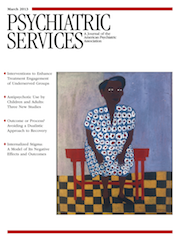Recovery Constructs and the Continued Debate That Limits Consumer Recovery
Abstract
It is generally agreed that the concept of recovery is the result of two primary influences: longitudinal studies and the work, writing, perspectives, and advocacy of the consumer-survivor movement. To clarify what is actually meant by recovery, investigators have compared and contrasted the constructs being conveyed through each primary influence. This process has resulted in the proposal of two main taxonomies—“recovery from” as opposed to “recovery in” and “recovery as an outcome” as opposed to “recovery as a process.” The author draws on her experience as a consumer to examine the efficacy of distinguishing the recovery constructs in each of these ways, concluding that both taxonomies limit the consumer recovery paradigm in a way that is neither valid nor helpful. It is essential to the progress of recovery-based services that the mental health field avoid the trap of a dualistic, either-or approach to recovery that was once so prevalent.



